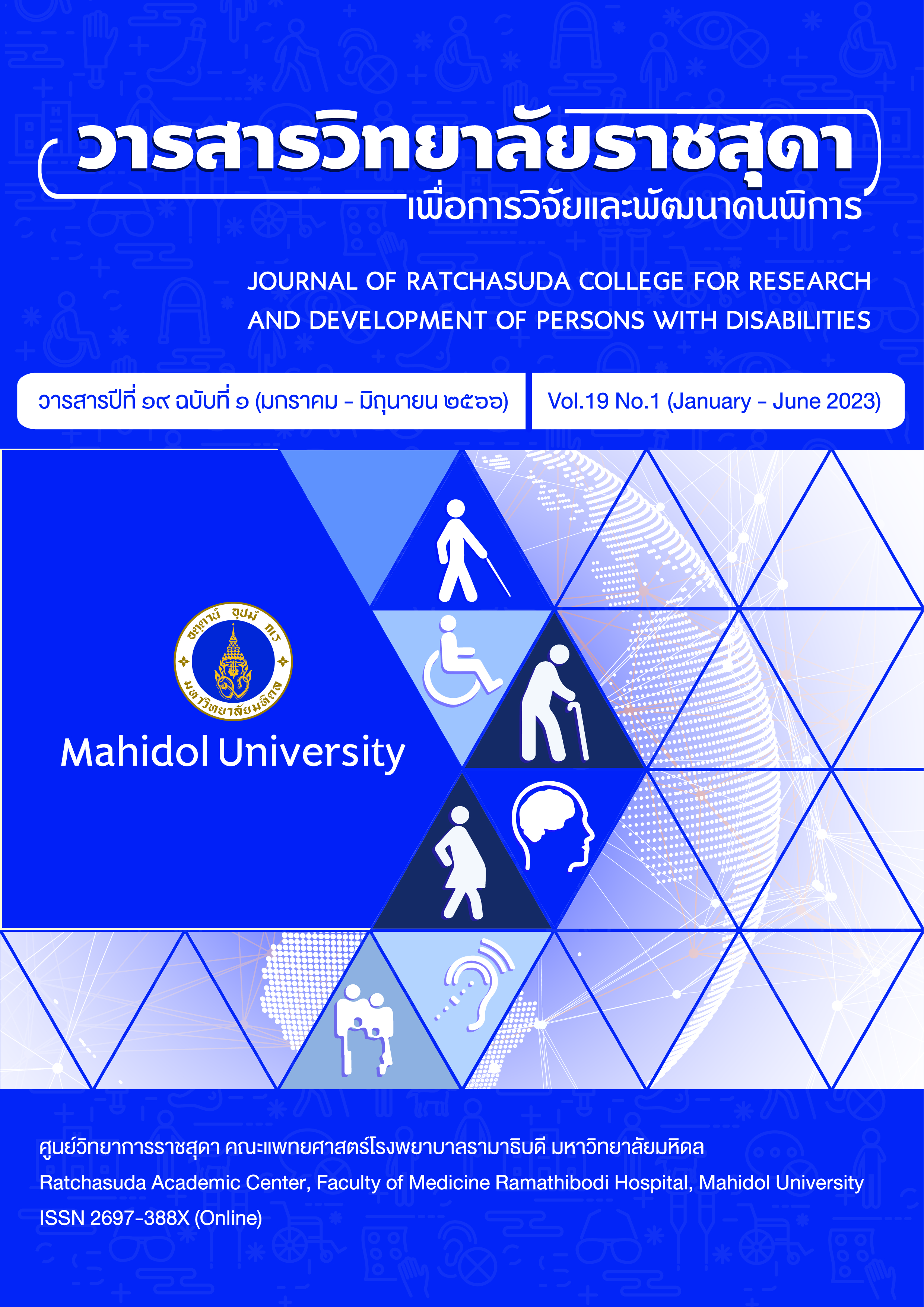The Study of Motorized Accessories for Towing Wheelchair with Innovative Problem-Solving Theory
Keywords:
Wheelchair, Design and Development, Theory of Inventive Problem Solving (TRIZ)Abstract
The objectives of this research were 1) to compare materials and accessories towing wheelchairs for the disabled, 2) to analyze wheelchairs for the disabled using innovative problem- solving theory, and 3) to assess the needs and necessities for wheelchair towing accessories for people with disabilities. The sample consisted of 30 people with mobility disabilities at the Center Production of Assistive Devices, Songkhla Province. The statistics used in the data analysis were mean, percentage, standard deviation and the Needs Assessment (PNI Modified). The results showed that the material used to create prototypes of wheelchair accessories for people with disabilities should be steel because it is cheaper, stronger, and more durable than aluminum. The use of motor systems and electric brake to drive wheelchair accessories allows people with disabilities to do activities and travel independents. The method of use can be disassembling the towing device and assembled with a wheelchair. The steel structure is used as a substitute material that can be easily serviced as a prototype equipment for the mobility disabilities who can travel independently for self-activity
Downloads
References
Ananda, S., Oishee, M., Prasanna,K.L., & Subhasis, B. (2016). Omnidirectional Assistive Wheelchair: Design and Control with Isometric Myoelectric Based Intention Classification. Procedia Computer Science, 17-20.
Benjaboonyasit, T. (2009). Learn TRIZ creativity. (1st ed). Bangkok: Institute of Human Resource Thammasat University.
Castillo, B. (2018). Auxiliary mobility system for a wheelchair. United State Patent No. US 9,872,805 B2.
Chachee, V. (2011). TRIZ: Theory of Inventive Problem Solving. The Far Eastern University, 5(2).
Chien,C.S., Huang,T.Y., Liao,T.Y. and Lee,T.M. (2014). Design and development of sola power-assisted manual/electric wheelchair. JRRD, 51(9). 1411-1426.
Cronbach, L. J. (1990). Essentials of psychological testing (5th ed.). New York: Harper & Row.
Donluem, S. & Nakthung, B. (2012). Development of Low Cost Wheelchairs for Disabled Persons. (Unpublished master’s thesis). Rajamangala University of Technology Isan, Nakhon Ratchasima, Thailand.
Huang, C.K., Lin, C.N., Konno, H., Ochiai, K., Tsuda, K,. & Wang, S.H. (2006). Motorized apparatus for towing a wheelchair. United State Patent No. US 2006/0000664 A1.
Janssen, T.W., Oers, C.A., Woude L.H. & Hollander, A.P., (1994). Physical strain in daily life of wheelchair users with spinal cord injuries. Medicine and Science in Sports and Exercise, 26(6). 661-670.
Jongkol, P. (2018). An Anthropometic Measurement and Analysis of Wheelchair Users. (Unpublished master’s thesis). Suranaree University of Technology, Nakhon Ratchasima, Thailand.
Kotesopa, S. (2012). Electric Wheelchair Control and Wireless Health Status Monitoring for the Handicapped and the Elderly. (Unpublished master’s thesis). Dhurakij Pundit University, Bangkok, Thailand.
Ruptean, L. and Mugcha, N. (2013). Wheelchair Electric 2 System. (Unpublished master’s thesis). Nakhon Pathom Technical College, Nakhon Pathom, Thailand.
SamilaTime. (2020). Happiness Production Center Audacious Prosthetics Community. Retrieved from http://www.samilatimes.co.th/?p=62034.
Sirindhorn National Medical Rehabilitation Institute. (2017). Handbook of care for People with Spinal cord injuries (Paraplegia). (1st ed). Medical Department: Ministry of Health.
Sirindhorn National Medical Rehabilitation Centre. (2014). Under the title Wheelchair service training package Reference manual for participant Basic level. (2nd ed). Medical Department: Ministry of Health.
Thai Health Promotion Foundation. (2013). Sang Suk (144). Community Newsletter Health lover.
The United Nations Convention on the Rights of Persons with a Disability (UNCRPD). (2008). Convention on the Rights of Persons with Disabilities (CRPD). Department of Economic and Social Affairs Disability: United Nations.
Verasirivuttana, S. & Keatchum, M. (2013). Development of voice-controlled wheelchairsvia wireless devices line. Journal of Science: Chandrakasem Rajabhat University, 28(4).
Vongvanit, S. (2007). Need-based Assessment research in Needed. Bangkok: Chulalongkorn University publisher.
Vorakum, P. (2013). Education research printing (6th ed). Maha Sarakham: Lak Sila Printing.
Downloads
Published
How to Cite
Issue
Section
License
Copyright (c) 2023 Ratchasuda Academic Center, Faculty of Medicine Ramathibodi Hospital, Mahidol Universityบทความที่ได้รับการตีพิมพ์เป็นลิขสิทธิ์ของวารสารสถาบันราชสุดาเพื่อการวิจัยและพัฒนาคนพิการ






